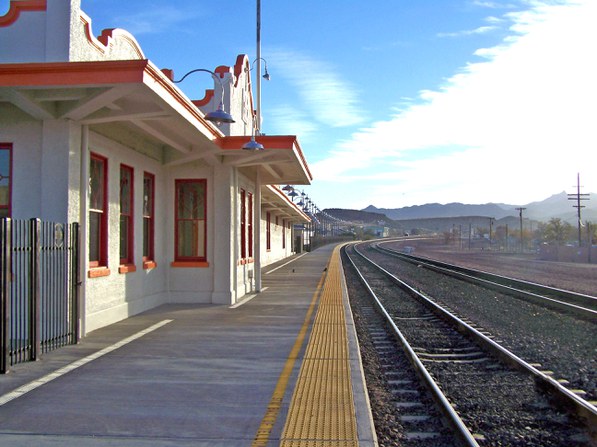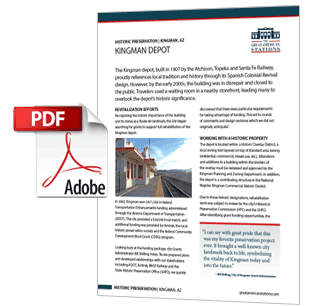The Kingman depot, built in 1907 by the Atchison, Topeka and Santa Fe Railway, proudly references local tradition and history through its Spanish Colonial Revival design. However, by the early 2000s, the building was in disrepair and closed to the public. Travelers used a waiting room in a nearby storefront, leading many to overlook the depot’s historic significance.
Revitalization Efforts
Recognizing the historic importance of the building and its status as a Route 66 landmark, the city began searching for grants to support full rehabilitation of the Kingman depot.
In 2002, Kingman won $471,500 in federal Transportation Enhancements funding administered through the Arizona Department of Transportation (ADOT). The city provided a $28,500 local match, and additional funding was provided by Amtrak, the local historic preservation society and the federal Community Development Block Grant (CDBG) program.
Looking back at the funding package, city Grants Administrator Bill Shilling notes, “As we prepared plans and developed relationships with our stakeholders including ADOT, Amtrak, BNSF Railway and the State Historic Preservation Office (SHPO), we quickly discovered that there were particular requirements for taking advantage of funding. This led to rounds of comments and design revisions which we did not originally anticipate.”
Working with a Historic Property
The depot is located within a Historic Overlay District, a local zoning tool layered on top of standard area zoning (residential, commercial, mixed-use, etc.). Alterations and additions to a building within the borders of the overlay must be reviewed and approved by the Kingman Planning and Zoning Department. In addition, the depot is a contributing structure in the National Register Kingman Commercial Historic District.
Due to these historic designations, rehabilitation work was subject to review by the city’s Historical Preservation Commission (HPC) and the SHPO. After identifying grant funding opportunities, the rehabilitation plan was presented to the HPC, which provided comments before endorsing the project to the City Council. The use of federal funds also required the project be undertaken in accordance with theSecretary of the Interior’s Standards for the Treatment of Historic Properties, a set of federal guidelines concerning the rehabilitation, restoration and preservation of historic structures.
The city chose to work with an architectural firm specializing in historic preservation. Rehabilitation work included repairs to the exterior stucco, restoration of the original doors and windows, refinishing of concrete floors, installation of new heating, plumbing and electrical systems, painting and landscaping. As part of the project, Amtrak constructed a new ADA accessible, 700-foot long concrete platform.
“I can say with great pride that this was my favorite preservation project ever. It brought a well-known city landmark back to life, symbolizing the vitality of Kingman today and into the future.” – Bill Shilling, City of Kingman Grants Administrator
Station as an Anchor
Following years of planning and patience, the depot officially reopened in spring 2011. The project, along with other city revitalization efforts, capitalizes on the public’s interest in Route 66, a historic roadway made famous across the world through movies, television programs, literature and art.
Its architectural features, highlighted in vibrant orange, allow the depot to truly stand out as a centerpiece of the downtown’s revival. One half is used for the Amtrak waiting room and office space, while the other half houses a popular railroad museum.
Keys to Success
- Worked with a historic preservation architect to ensure compliance with local, state and national historic preservation regulations.
- Considered depot as one component of larger economic development and tourism strategy.
- Included museum to ensure depot remains busy throughout the day.




 Amtrak established the Great American Stations Project in 2006 to educate communities on the benefits of redeveloping train stations, offer tools to community leaders to preserve their stations, and provide the appropriate Amtrak resources.
Amtrak established the Great American Stations Project in 2006 to educate communities on the benefits of redeveloping train stations, offer tools to community leaders to preserve their stations, and provide the appropriate Amtrak resources. Amtrak is seizing a once-in-a-lifetime opportunity to transform rail and Retrain Travel. By modernizing, enhancing and expanding trains, stations and infrastructure, Amtrak is meeting the rising demand for train travel. Amtrak offers unforgettable experiences to more than 500 destinations across 46 states and parts of Canada. Learn more at
Amtrak is seizing a once-in-a-lifetime opportunity to transform rail and Retrain Travel. By modernizing, enhancing and expanding trains, stations and infrastructure, Amtrak is meeting the rising demand for train travel. Amtrak offers unforgettable experiences to more than 500 destinations across 46 states and parts of Canada. Learn more at